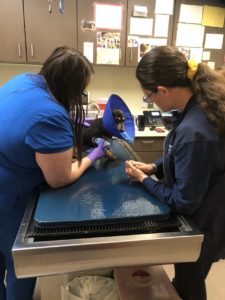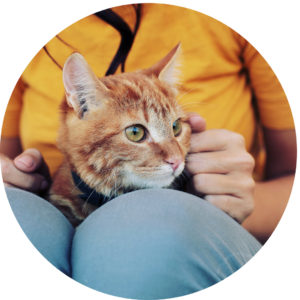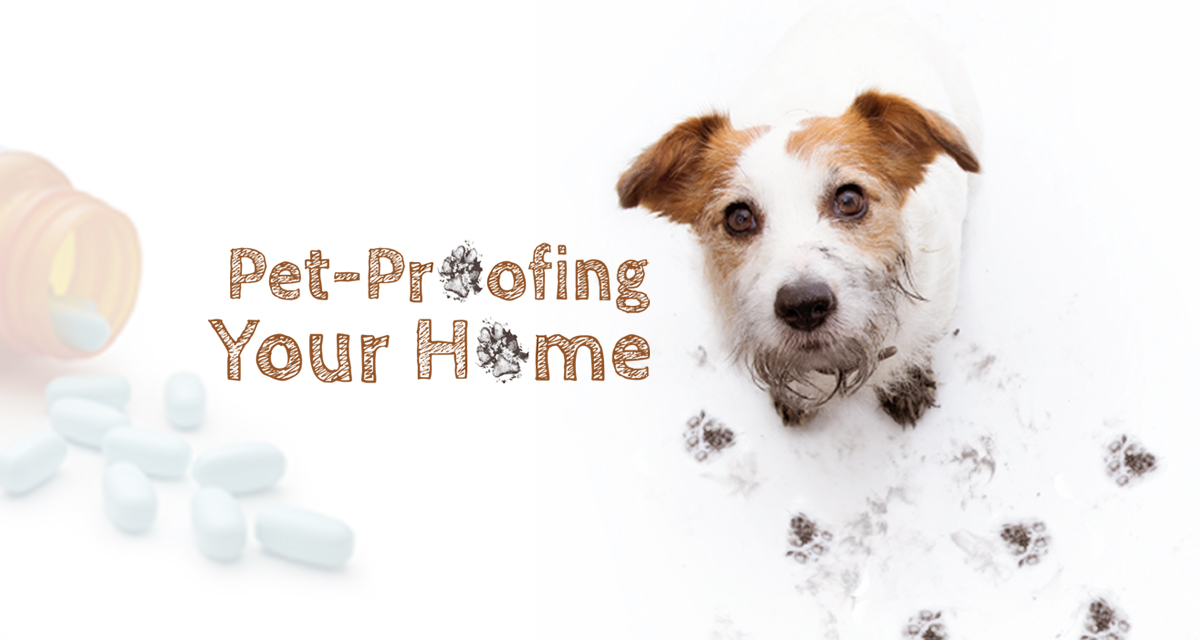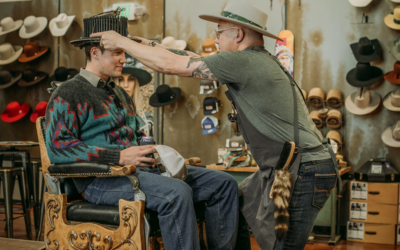If you’re a pet owner, odds are you’ve come home to an unpleasant surprise: trash on the floor or pieces of a treasured heirloom, accompanied by vomit. Maybe you’ve even ended up at an emergency clinic for surgery to remove plastic, string or something gross.
Even if you’ve never had to rush your pet to the vet, your home may still be harboring everyday toxins, such as certain foods, medications and household cleaners.

Dr. Ayla R. Preston Critical care specialist/ICU director, Four Seasons Veterinary Specialists
The worst offenders tend to be medications, according to Dr. Ayla R. Preston, critical care specialist and emergency room ICU director at Four Seasons Veterinary Specialists, in Loveland. “Most medications come in a childproof bottle, but dogs have really sharp teeth and strong jaws so it’s easy for them to break those open,” she says. “Even if they are just playing with it, sometimes they’ll inadvertently puncture a hole thinking it’s a chew toy.”
If dogs can break through pill bottles, it goes without saying that dated pill containers and medications in plastic bags pose even more of a risk. Even if they are kept up on the counter, the cat can knock them off, allowing the dog to chew them up. Purses and suitcases aren’t a safe place for medications either if they are left within reach.
“Tylenol, Advil and other forms of ibuprofen are common for pets to get into, as well as vitamins and supplements,” Preston says. “We also see a lot of pets that have ingested antidepressant drugs or bitten into albuterol inhalers. We don’t understand why some pets are attracted to those things, besides the fact that they’re curious because they are new to them.”
There are plenty of household chemicals toxic to pets. Antifreeze and rodenticides can be especially palatable for dogs and cats and deadly when ingested. Antifreeze has a sweet scent, and even chemicals that have a harsh or unpleasant smell, like a bleach solution left in a bucket for mopping, can be tempting for pets.

Dr. Mickey C. Wiltz Senior Veterinarian/owner, Big Thompson Animal Hospital
Preston says that many essential oils and liquid potpourri products are also toxic because they contain ingredients that are rapidly absorbed, even through the skin. It’s best to keep your pet in another room when you are using those products and store them out of reach rather than on the counter.
Plants are a different story. Many houseplants are indeed toxic, but in most cases, they would have to bite off and swallow a significant amount to do much harm, says Dr. Mickey C. Wiltz, senior veterinarian and owner of Big Thompson Animal Hospital, in Loveland. Most houseplants that are considered toxic don’t taste good to pets, so they tend to nibble them and then leave them alone.
 “Oleander, belladonna and other nightshades do have real toxicities that can be extremely harmful, but they aren’t common,” he says. “Then there are toxic plants like poinsettias that can cause an upset stomach, although they aren’t usually deadly. The most common plant we see issues with is marijuana, both in the edible and smokable form. It very seldom causes life-threatening problems in dogs or cats, but they certainly still get sick.”
“Oleander, belladonna and other nightshades do have real toxicities that can be extremely harmful, but they aren’t common,” he says. “Then there are toxic plants like poinsettias that can cause an upset stomach, although they aren’t usually deadly. The most common plant we see issues with is marijuana, both in the edible and smokable form. It very seldom causes life-threatening problems in dogs or cats, but they certainly still get sick.”
Preston points out that lily ingestion can cause kidney failure in cats, and lilies happen to be common in bouquets kept on the table or countertop: “Cats are amazing jumpers, and they are very curious, so it’s not worth the risk to leave lilies in a bouquet even if it’s kept up high,” Preston says. “I advise that cat owners use extreme caution and dispose of lilies in a dumpster outside, just to be safe.”
That brings us to the trash can, seemingly harmless place to discard candy wrappers, old packs of gum, fruit pits and picked-off bones. All of these things can be an issue for pets. Make sure your receptacle has a tight lid and can’t be easily knocked over.
Foods that are toxic to pets include chocolate, grapes, raisins, coffee grounds, alcohol and Xylitol (a common ingredient in sugar-free gum, candy and toothpaste), though there are plenty of other unsafe foods that can cause less severe reactions. For example, the American Society for the Prevention of Cruelty to Animals lists onions, garlic and chives as problematic for pets.
That’s why many vets warn against feeding your pet “human” food: You never know how the animal will react, and it may cause them to seek out other foods on the counter or in the trash. And it’s not always the food itself that’s the problem. Sometimes it’s what’s left over, like peach pits and chicken bones, that end up causing an obstruction.
Wiltz says it’s more common for him to see pets that have an obstruction or some other type of physical injury than symptoms from ingesting a household toxin. Often these include rocks and broken pieces of bone, not to mention strands of rope and fabric from stuffed animals, toys and clothing. Depending on the severity of the situation, he’ll either help the object pass through or remove it via surgery.
 “There are some dogs that are going to tear up their toys to a point where it might not be safe to give them any toys at all,” he says. “Dogs also love chewing on a bone, but they can chew off big chunks they can’t digest. In most cases their teeth also aren’t as hard as the bone, so that can lead to chipped or fractured teeth. I’ve seen rawhide obstructions too, but that doesn’t happen nearly as often. Greenies and Nylabones work really well as a substitute and are much easier on the teeth.”
“There are some dogs that are going to tear up their toys to a point where it might not be safe to give them any toys at all,” he says. “Dogs also love chewing on a bone, but they can chew off big chunks they can’t digest. In most cases their teeth also aren’t as hard as the bone, so that can lead to chipped or fractured teeth. I’ve seen rawhide obstructions too, but that doesn’t happen nearly as often. Greenies and Nylabones work really well as a substitute and are much easier on the teeth.”
Cats can also ingest these types of things, but many blockages tie back to string. Preston notes that dental floss commonly causes intestinal obstructions in cats, which they tend to dig out of the bathroom trash. Outdoor cats that hunt small animals can also end up with lodged pieces of bone.
Other physical injuries that often occur in the backyard include cuts from landscape edging and abscesses from foxtail grass seed, a barbed seed with one-way spikes that allow for easy burrowing. Unfortunately, these seeds can do the same thing in between your dog’s toes and behind their ears, which is why Wiltz recommends taking a moment to brush their coat and remove grass seeds after every walk.
The number-one piece of advice Preston and Wiltz have is to keep toxic or otherwise dangerous materials up and away, perhaps in a cabinet with a childproof lock, the back of a drawer or disposed of in a sturdy trash can with a lid. And things that are extremely toxic to pets, like rodenticides and antifreeze, might not be worth having at all.
If you suspect that your pet has gotten into something, like a bottle of pills or your kids’ Halloween candy, don’t hesitate to bring them to the vet. It’s always better to have a false alarm than for it to be too late. Signs to look for include items that have been chewed up or strewn about the house, or strange behavior from your pet, such as a decreased appetite, vomiting, diarrhea, lethargy, anxiety, wobbliness, dribbling urine or hiding (especially in cats).

“Immediate intervention is important to prevent signs of illness later down the road that aren’t always obvious right away,” Preston says. “Your vet might want to induce vomiting just to be sure they haven’t swallowed any medication, or they might do other types of scans. I also don’t think it’s ever wrong to call the ASPCA Animal Poison Control Center to consult with them about whatever your pet may have ingested.”
For a list of plants, foods and other household items that are toxic to pets, visit the ASPCA website, aspca.org. The ASPCA Animal Poison Control Center can be reached anytime at 888.426.4435.







